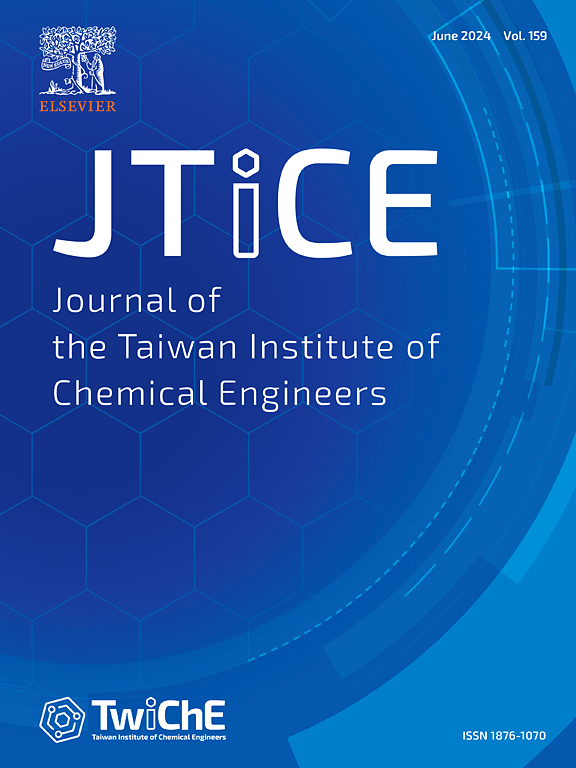利用纳米铜可持续地一锅多组分合成1,4-二氢吡啶、苄基丙二腈和四氢苯并[b]吡喃:绿色化学指标和抗氧化潜力的探索
IF 5.5
3区 工程技术
Q1 ENGINEERING, CHEMICAL
Journal of the Taiwan Institute of Chemical Engineers
Pub Date : 2025-06-27
DOI:10.1016/j.jtice.2025.106249
引用次数: 0
摘要
一锅可持续方法的发展是有机合成和药物化学领域关注的热点。研究人员致力于开发一锅多组分反应(mcr),以利用新型纳米材料获得杂环支架。本文探讨了生物氧化亚铜纳米颗粒(BCONPs)在mcr中的催化性能以及绿色化学指标的探索,以确保反应的可持续性。方法采用绿色共沉淀法合成纳米催化剂,采用FT-IR、P-XRD、XPS、TEM、FE-SEM、EDX等多种表征技术对催化剂进行表征;并表现出优异的催化活性。已开发的方案提供1,4-二氢吡啶(1,4- dhps),苄基丙二腈和四氢苯并[b]吡喃(THBP)衍生物。基于电子抽取和电子捐赠的影响,评估了各种绿色化学指标,如TON、TOF、AE、AEf、RME、OE和e因子,证明了工艺的有效性、可持续性和可扩展性。同时,计算每个开发方案的EcoScale评分。此外,还考察了各化合物的体外和硅内抗氧化能力。现有的方法在温和的条件下高产出了重要的杂环支架,包括1,4- dhps和thbp以及苯并二甲基丙二腈,并对各种功能进行了探索,同时探索了绿色化学指标。每个方案的EcoScale评分均达到75%以上。这些BCONPs适用于克级合成,可循环使用5次,保持催化功能。1,4-二磷酸具有优异的抗氧化活性,尤其是具有给电子官能团的二磷酸。本文章由计算机程序翻译,如有差异,请以英文原文为准。
![Sustainable, one-pot multicomponent synthesis of 1,4-dihydropyridines, benzylidene malononitriles and tetrahydrobenzo[b]pyrans using copper nanoparticles: Exploration of green chemistry metrics and antioxidant potential](https://img.booksci.cn/booksciimg/2025-6/102305004121782189594.jpg)
Sustainable, one-pot multicomponent synthesis of 1,4-dihydropyridines, benzylidene malononitriles and tetrahydrobenzo[b]pyrans using copper nanoparticles: Exploration of green chemistry metrics and antioxidant potential
Background
Development of one-pot sustainable methodologies are of high interest in organic synthesis and medicinal chemistry. Researchers focused their efforts for the development of one-pot multicomponent reactions (MCRs) to access heterocyclic scaffolds utilising novel nanomaterials. Herein, the catalytic performance of biogenic cuprous oxide nanoparticles (BCONPs) was explored in MCRs along with exploration of green chemistry metrics, ensuring sustainable aspects of reactions.
Methods
Nanocatalyst was synthesized by green co-precipitation method and characterized by variegated characterization techniques including FT-IR, P-XRD, XPS, TEM, FE-SEM, and EDX; and demonstrated excellent catalytic activity. Developed protocols afforded 1,4-dihydropyridines (1,4-DHPs), benzylidene malononitrile, and tetrahydrobenzo[b]pyran (THBP) derivatives. Various green chemistry metrics such as TON, TOF, AE, AEf, RME, OE, and E-factor for each derivative based on electron withdrawing and donating influence was evaluated which proved efficacy, sustainability, and scalability of the processes. Also, EcoScale score was calculated for each developed protocol. In addition, in vitro and in silico antioxidant potential of all compounds was explored.
Significant Findings
Developed methods afforded important heterocyclic scaffolds including 1,4-DHPs, and THBPs along with, benzylidene malononitriles in high yields under mild conditions tolerating various functionalities with exploration of green chemistry metrics. An EcoScale score above 75 % was achieved for each protocol. These BCONPs were applicable for gram scale synthesis and recyclable up to five times, sustaining catalytic function. 1,4-DHPs especially with electron donating functionalities showed excellent antioxidant activity.
求助全文
通过发布文献求助,成功后即可免费获取论文全文。
去求助
来源期刊
CiteScore
9.10
自引率
14.00%
发文量
362
审稿时长
35 days
期刊介绍:
Journal of the Taiwan Institute of Chemical Engineers (formerly known as Journal of the Chinese Institute of Chemical Engineers) publishes original works, from fundamental principles to practical applications, in the broad field of chemical engineering with special focus on three aspects: Chemical and Biomolecular Science and Technology, Energy and Environmental Science and Technology, and Materials Science and Technology. Authors should choose for their manuscript an appropriate aspect section and a few related classifications when submitting to the journal online.

 求助内容:
求助内容: 应助结果提醒方式:
应助结果提醒方式:


